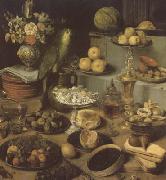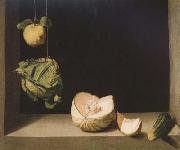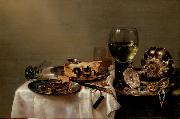
|
Georg Flegel
|
|||
|
|
|||
| 1566-1638 Georg Flegel Location German painter. He was the son of a shoemaker, and not being a Roman Catholic, probably moved to Vienna after 1580, when the Counter-Reformation began to take effect in Olmetz. In Vienna he became the assistant of Lucas van Valckenborch I, whom he subsequently followed to Frankfurt, then an important centre for art dealing and publishing. He filled in staffage in van Valckenborch pictures of the seasons and portraits, inserting fruit, table utensils and flowers as still-life set pieces. His faithful reproduction of flowers and fruit drew on watercolours by Derer, still-life painters from the Netherlands living in Frankfurt, and botanical and zoological illustrations by Joris Hoefnagel, Pieter van der Borcht IV and Carolus Clusius (1525-1609) then being published in Frankfurt. | |||
|
|
|||
|
Still Life (mk08) new6/Georg Flegel-668376.jpg Painting ID:: 21611 |
Oil on copper 78x67cm Munich,Bayerische Staatsgemalde-summlungen,Alte Pinakothek | ||
|
|
|||
|
Juan Sanchez-Cotan
|
|||
|
|
|||
| Spanish 1561-1627 S??nchez Cot??n was born in the town of Orgaz, near Toledo. He was a friend and perhaps pupil of Blas de Prado, an artist famous for his still lifes whose mannerist style with touches of realism, the disciple developed further. Cot??n began by painting altar pieces and religious works. For approximately twenty years, he pursued a successful career in Toledo as an artist, patronized by the city??s aristocracy, painting religious scenes, portraits and still lifes. These paintings found a receptive audience among the educated intellectuals of Toledo society. S??nchez Cot??n executed his notable still lifes around the turn of the seventeenth century, before the end of his secular life. An example (seen above) is Quince, Cabbage, Melon and Cucumber (1602, in the San Diego Museum of Art). On August 10, 1603, Juan Sanchez Cotan, then in his forties, closed up his workshop at Toledo to renounce the world and enter the Carthusian monastery Santa Maria de El Paular. He continued his career painting religious works with singular mysticism. In 1612 he was sent to the Granada Charterhouse, he decided to become a monk, and in the following year he entered the Carthusian monastery at Granada as a laybrother. The reasons for this are not clear, though such action was not unusual in Cot??n??s day. Cotan was a prolific religious painter whose work, carried out exclusively for his monastery, reached its peak about 1617 in the cycle of eight great narrative paintings which he painted for the cloister of the Granada Monastery. These depict the foundation of the order of St. Bruno, and the prosecution of the monks in England by the Protestants. Although the painter??s religious works have an archaic air, they also reveal a keen interest in the treatment of light and volumes, and in some respect are comparable with certain works by the Italian Luca Cambiaso whom Cotan knew at the Escorial. While Cotan's religious works are unexceptional, as a still-life painter he ranks with the great names of European painting. In spite of his retreat from the world, Cotan??s influence remained strong. His concern with the relationships among objects and with achieving the illusion of reality through the use of light and shadow was a major influence on the work of later Spanish painters such as Juan van der Hamen, Felipe Ramirez, the brothers Vincenzo and Bartolomeo Carducci and, notably, Francisco de Zurbaran. Sanchez Cotan ended his days universally loved and regarded as a saint. He died in 1627 in Granada. | |||
|
|
|||
|
Still Life (mk08) new6/Juan Sanchez-Cotan-885978.jpg Painting ID:: 21613 |
c.1602 Oil on canvas 65x81cm San Diego,The Fine Arts Gallery of San Diego | ||
|
|
|||
|
SNYDERS, Frans
|
|||
|
|
|||
| Flemish Baroque Era Painter, 1579-1657 Flemish painter and draughtsman, active also in Italy. He was the progenitor of Flemish Baroque still-life and animal painting. He worked intensively for about 50 years, producing an enormous body of works, of which more than 300 paintings survive , along with some oil sketches and about 100 drawings. | |||
|
|
|||
|
Still Life (mk08) new6/SNYDERS, Frans-534532.jpg Painting ID:: 21713 |
1614 Oil on canvas 156x218cm Cologne,Wallraf-Richartz-Museum | ||
|
|
|||
|
HEDA, Willem Claesz.
|
|||
|
|
|||
| Dutch painter (b. 1594, Haarlem, d. 1680, Haarlem). Dutch still-life painter. His excellent studies of tables laden with food, called ontbijt still life, are seen in many important European galleries. They are characterized by delicate lighting effects and somber colors. | |||
|
|
|||
|
Still Life (mk08) new6/HEDA, Willem Claesz.-432394.jpg Painting ID:: 21720 |
Oil on panel 54x82cm Dresden,Gemaldegalerie Alte Meister | ||
|
|
|||
|
Jan Davidsz. de Heem
|
|||
|
|
|||
| stilllife masters, Dutch Baroque Era Painter, 1606-C.1683 | |||
|
|
|||
|
Still Life (mk08) new6/Jan Davidsz. de Heem-687582.jpg Painting ID:: 21754 |
Oil on panel. 55.8x73.5cm Gent,Museum voor Schone Kunsten | ||
|
|
|||
|
Also Buy::. For Following Paintings / Artists / Products, Please Use Our Search Online: |












